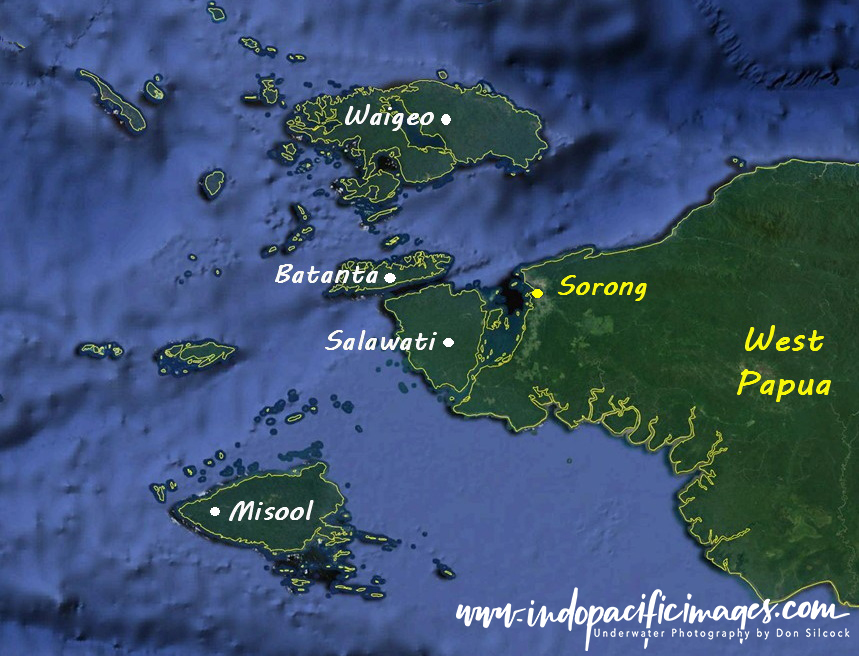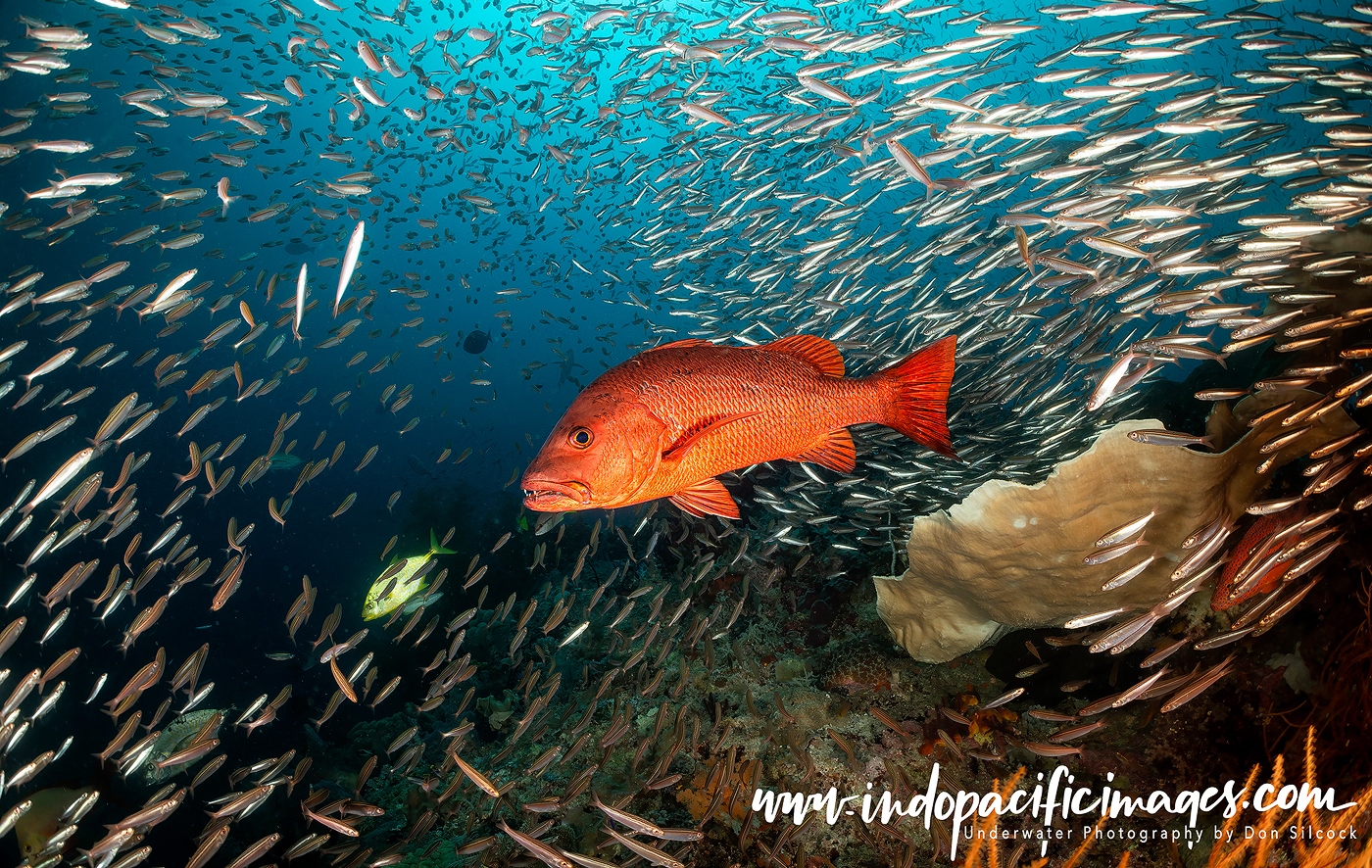
Diving Misool… The second king – Misool, the large, remote, and sparsely populated island that is the second biggest of Raja Ampat’s “four kings”.
It is said that the name Raja Ampat derives from the local folklore story of a woman who finds seven eggs. Four of which hatched and the hatchlings grew to become the kings of those four islands – Waigeo, Misool, Sulawati and Batanta.
Located some 150kms from the main regional city of Sorong. It’s a 5-hour journey by fast boat if you are one of the lucky ones staying on the island. Or an overnight sail if you are one of the lucky ones visiting on a liveaboard.
Either way you are lucky… Because Misool has some of the very best diving in all of Raja Ampat. An overall area renowned as probably the best and most biodiverse tropical diving in the world.

Marine Biodiversity – A Blessing and a Curse
If you were to make one of those journeys. And woke the next morning in the south-east corner of Misool, you should truly count your blessings. As you are in what is effectively a privately managed marine reserve.
The Misool Marine Reserve is akin in many ways to an African game reserve. Where poachers are kept out and the animals, under the active protection of rangers, are able to thrive as nature intended them to. That incredibly rich marine biodiversity has always been there. Thriving in the rich currents that sweep through the area from the north. And the upwellings that flow creates from the deep waters of the Seram Trough to the south. It’s just that nobody really knew it was there…
Among the first to realise just how rich the area is were the poachers of the sea. Illegal fishing boats plundering the marine life and shark finners decimating the shark population. The very remoteness of the area enabling both the area to thrive in the first place. And the poachers to get away scott-free with what they were doing.

Diving Misool – Andy and Marit Miners

It’s almost impossible to overstate just how pivotal this Anglo-Swedish couple have been in restoring Misool to its current condition.
But consider this basic set of facts… When they first arrived in the area in the early 2000’s aboard the liveaboard Andy was managing. There was a full-blown shark finning operation set up on the beach at Batbitim Island.
The shallow waters off the beach was a graveyard for the de-finned shark corpses and rampant cyanide and dynamite fishing were decimating the reefs and marine life.
The Miners decided they had no option but to get involved and set about creating what has, in many ways, become the de-facto role-model for successful and sustainable ecotourism based on working with and empowering the local community.
Diving Misool – The Misool Foundation
At the very heart of what has been achieved in restoring the marine biodiversity of south-east Misool is the Misool Foundation – the brainchild of Andy and Marit. Along with the partners they managed to bring on board to make it all happen.
The Foundation is the platform upon which all the good things that have been done, together with all the benefits that have flowed to the local community, is based. And it all started with the agreement that the Miner’s struck with the community in 2005 to lease Batbitim Island and a large area of the sea surrounding it.


Integral to that agreement was the island would become the location for Misool Eco Resort. And… the shark-finning operation would be evicted from the beach.
The Foundation went on to establish the Misool Marine Reserve. Which now protects an area of some 1200 km2 of prime maritime real estate (roughly twice the size of Singapore). And includes two distinct no-take zones where all fishing is banned.
It also finances the team of 20 local Rangers. Along with the Ranger Stations on the islands of Yellit, Kalig, and Daram. Plus five dedicated patrol boats that provide 24-hour monitoring of the Marine Reserve in conjunction with the Raja Ampat Marine Police.
Over 900 such patrols are conducted annually. With up to 50 illegal fishing boats intercepted every year.
The Results…
There simply is no data on the original biodiversity of south-east Misool either before or after the rampant destruction of the illegal fishing boats and shark finners.
But surveys conducted since 2007 provide an indication of what the original biodiversity may have been. Because of the changes observed since the creation of the Marine Reserve. Together wit the daily patrols to protect it.
- Since 2007 the fish biomass in the reserve increased by an average of 250%. And, in some key areas, by as much as 600%
- There are 25 times more sharks inside the reserve than outside of it.
- The total number of manta rays in the reserve has doubled.
- Sightings of rare oceanic mantas have increased 25-fold.

All this while Misool Eco Resort was built from scratch, entirely from locally reclaimed wood. Which was milled and shaped by a portable sawmill on the beach where the shark-finning operation had been. The resort is now firmly established as a high-end and highly sort after location. Which is often fully booked up one year in advance.
The resort and Misool Foundation employ more than 250 staff, 96% of whom are Indonesian. And it is estimated those salaries support around 1,000 people from the local community.
Diving Misool
 By far the best diving in Misool is in the south-east of the island. And it is concentrated along the two archipelagos that stretch out from the island towards the Seram Trough.
By far the best diving in Misool is in the south-east of the island. And it is concentrated along the two archipelagos that stretch out from the island towards the Seram Trough.
Remote and swept by the nutrient-rich currents and upwellings. The sheer density of marine life around parts of those archipelagos is simply stunning. And at times, almost too much to absorb, as there is just so much happening!
Superb ridges and valleys of beautiful and incredibly healthy sea fans filter the passing water for its nutrients. While huge schools of sardines and other baitfish sweep and swirl, blocking the sun completely when above you.
Almost everywhere you look is something exceptional and every sense you have is telling you that you are in a very special place!

 To the north is the Saghof-Daram archipelago with its stellar sites like Andiamo, Two-Tree Rock and Baby Rock offering spectacular diving. while the Southern archipelago with the wonderful Fiabacet, Anti-Chovie and Boo Windows dive sites are equally sensational.
To the north is the Saghof-Daram archipelago with its stellar sites like Andiamo, Two-Tree Rock and Baby Rock offering spectacular diving. while the Southern archipelago with the wonderful Fiabacet, Anti-Chovie and Boo Windows dive sites are equally sensational.
Then of course there are sites like Magic Mountain where the reef and oceanic manta rays hang out to be cleaned. Misool is one of the few places in the world where both species are seen regularly!
You get the picture – it’s good, really good… But perhaps a better description of it all is the one from Dr. Mark Erdmann, the VP of Conservation International’s Asia-Pacific marine programs:
“There is greater biodiversity — that is to say, a larger number and greater diversity of fish, coral, and molluscs — on these reefs than anywhere on earth. A single football field-sized patch of Misool’s reefs has nearly five times the number of coral species as the entire Caribbean Sea. Which covers a total area nearly as big as India!”
How to Dive Misool
There are two basic options to dive Misool… One is straightforward but expensive. While the other is more cost-effective, but more complicated.
The simple one is biting the bullet, booking well in advance and staying at Misool Eco Resort.
It will be expensive but remember that what you are paying for is something really quite exceptional. And, most importantly. it supports the overall sustainability of this unique area. The Eco Resort is high on my personal bucket list and something I have to do. I just need a bit more time to save up…
The alternative is of course one of the many liveaboards that feature Misool on their itineraries. This is a very logical choice as it allows you to move easily from site to site on both archipelagos. But all liveaboards are not created equally… Some are exceptional, but many are less so. My first trip to Misool was back in 2008 and last October I was back there for my tenth trip. Every one of those trips was on the same boat, the SMY Ondina.
SMY Ondina

Why the same boat you may ask? Well, I trust the Ondina having been caught in some very bad weather on it a few times. And I know that they know the sites in Misool (and Raja Ampat generally) very well and how to dive them at their best. Plus I know the person who supervised its construction – Raja Ampat diving pioneer Ricard Buxo.
In many ways the bottom line is that you will be diving in strong currents. In some very remote areas…. And need to know there is an effective and efficient surface support and tender system you can rely on to pick you up at the end of the dive.
In all the hundreds of dives I have done from Ondina I have never been let down, ever! Which is no small thing!
When to Dive Misool
While in theory Misool can be dived throughout the year the reality is that come June, the monsoonal winds mean big seas on both the Saghof-Daram and Southern archipelagos. Which make diving difficult and greatly reduce underwater visibility… The journey from Sorong also becomes increasingly uncomfortable and can start to get dangerous. So the Eco Resort closes to guests completely from mid-June through to September.
The liveaboard season tends to start later. Typically in November and usually goes through to around March. Although some boats do arrive earlier and stay later. Overall though the optimum months for Misool are from mid-October through to early April. As the weather tends to be good to very good and the surface conditions and underwater visibility are generally excellent apart from occasional heavy rain.

Diving Misool – In Summary…
Misool offers possibly the very best tropical diving in the world – a bold statement no doubt… but it truly is exceptional diving in an overall area that has been proven to have the highest marine biodiversity in the world! Some of the sites on the Saghof-Daram and Southern archipelagos are simply stunning and I can only hope that my images do them justice.
But here’s the thing about Misool… it’s basically as good as it gets in tropical diving and yet we nearly lost it to rampant and unfettered greed. The backstory to it all and the astonishingly successful leadership of Andy and Marit Miners in having the vision and commitment to marshal the resources needed to turn it all around makes Misool even more special.
It really is one of those places you have to see for yourself!
